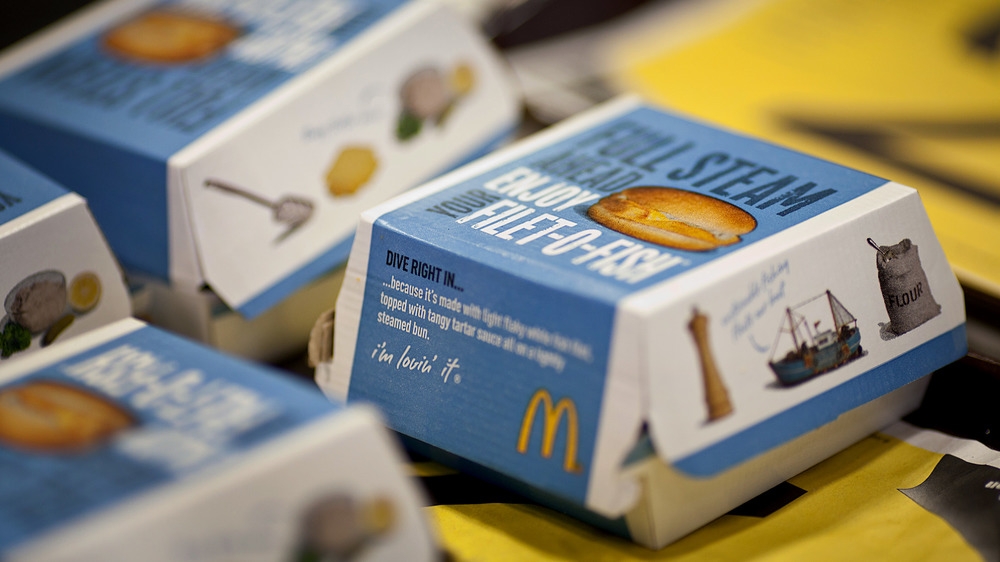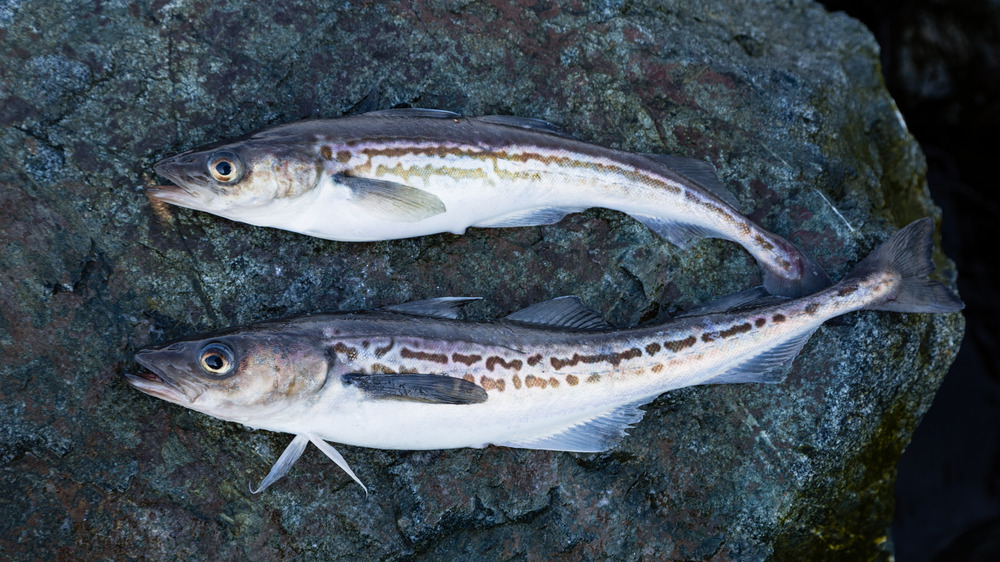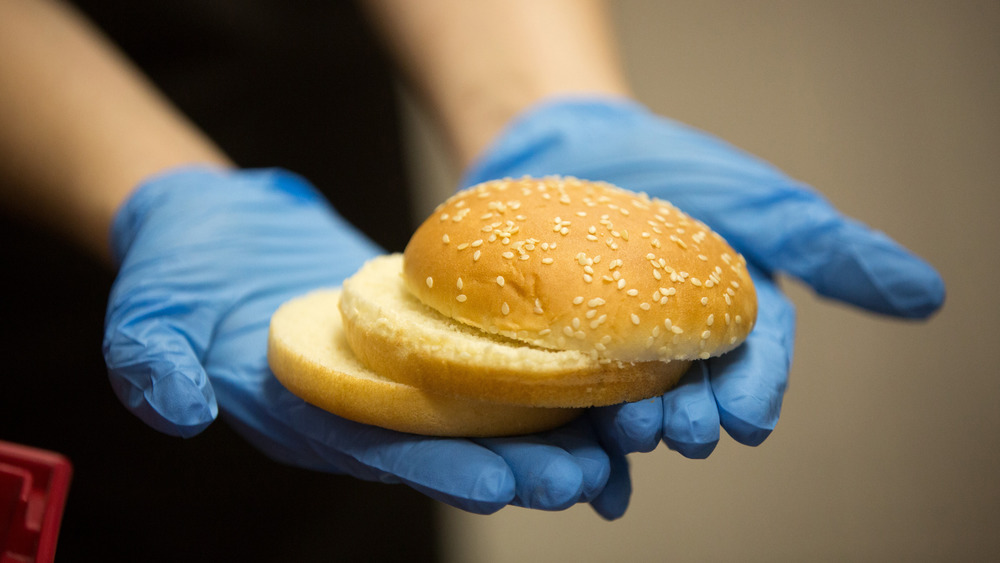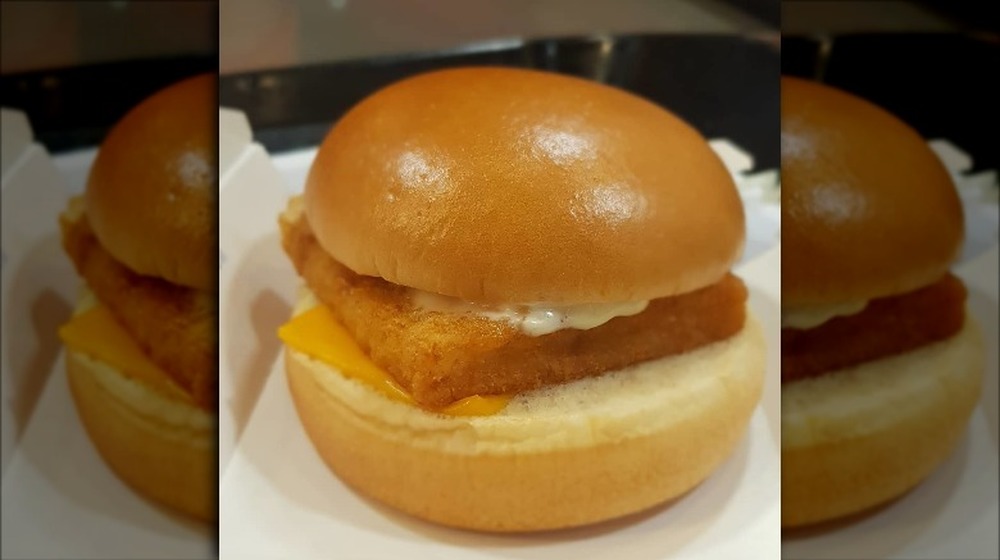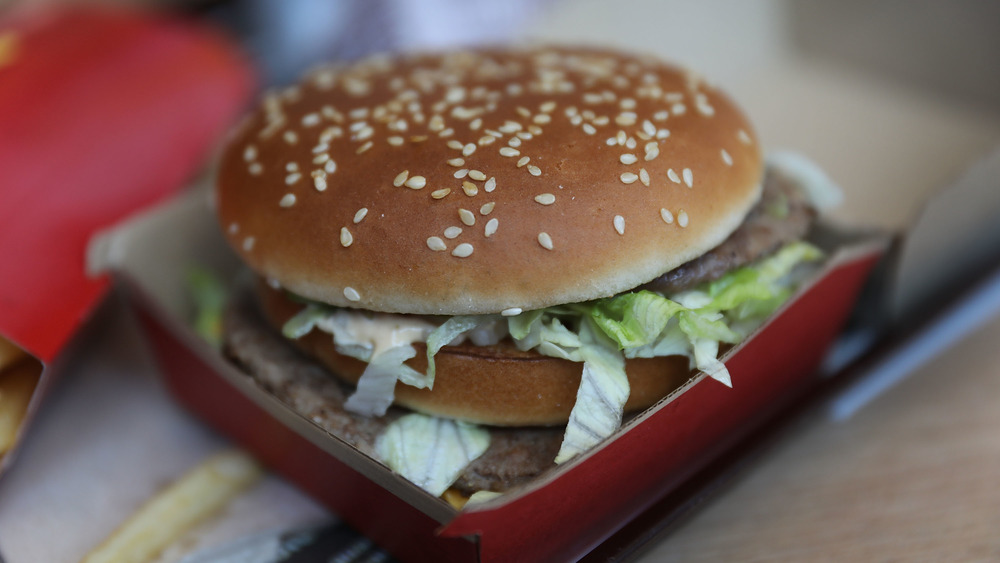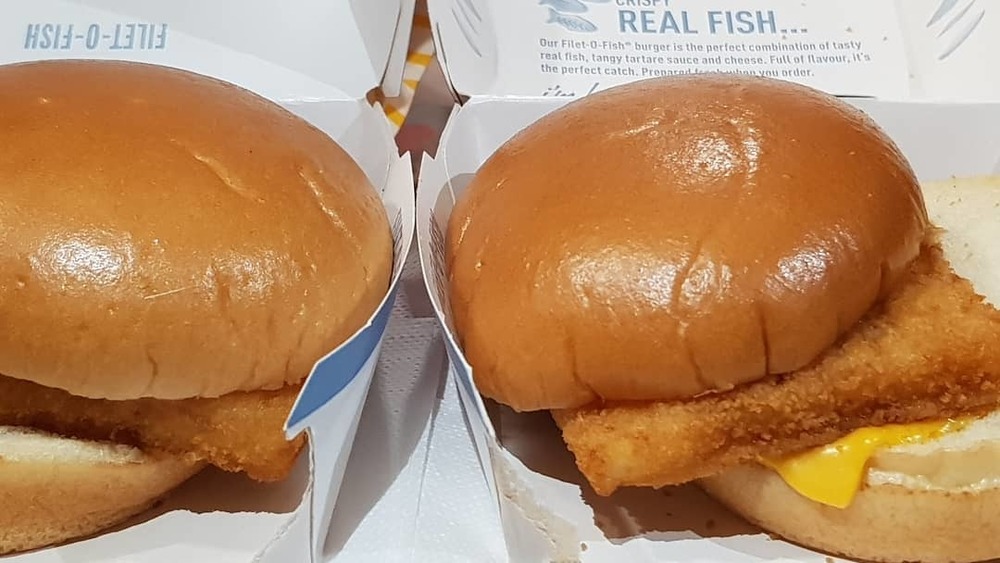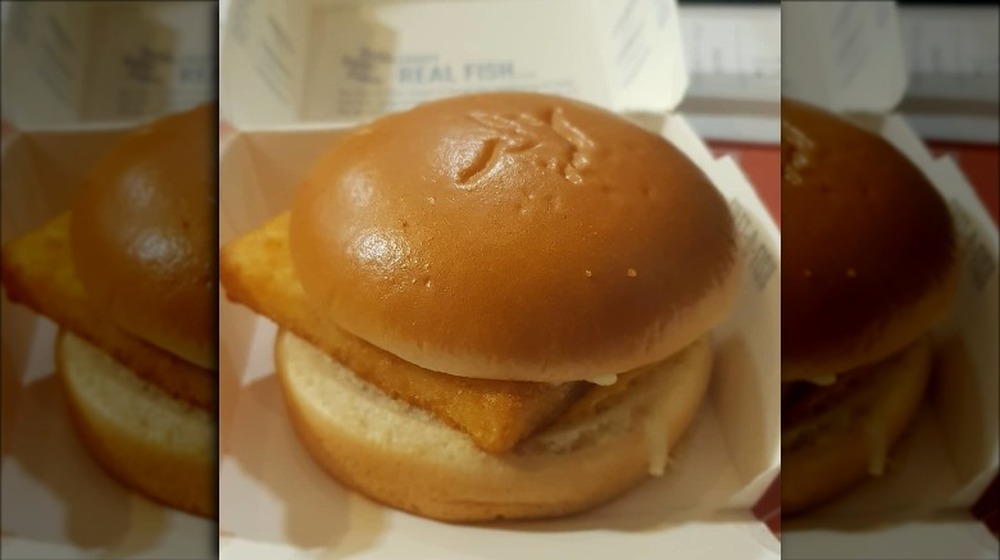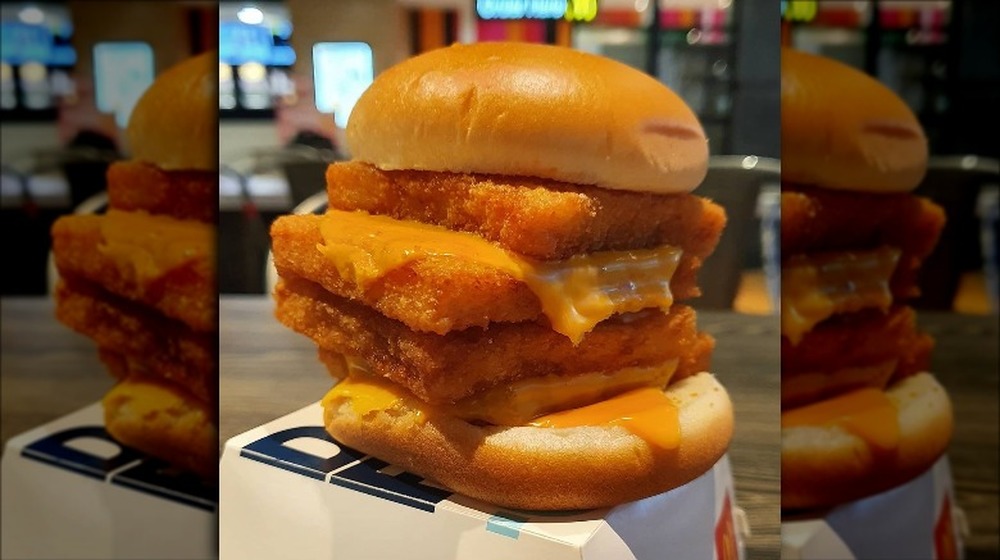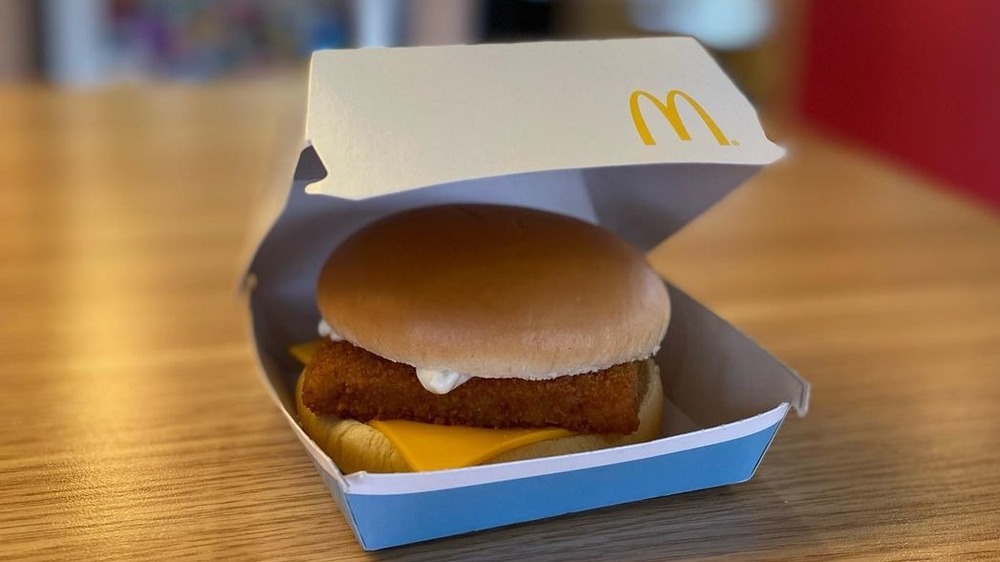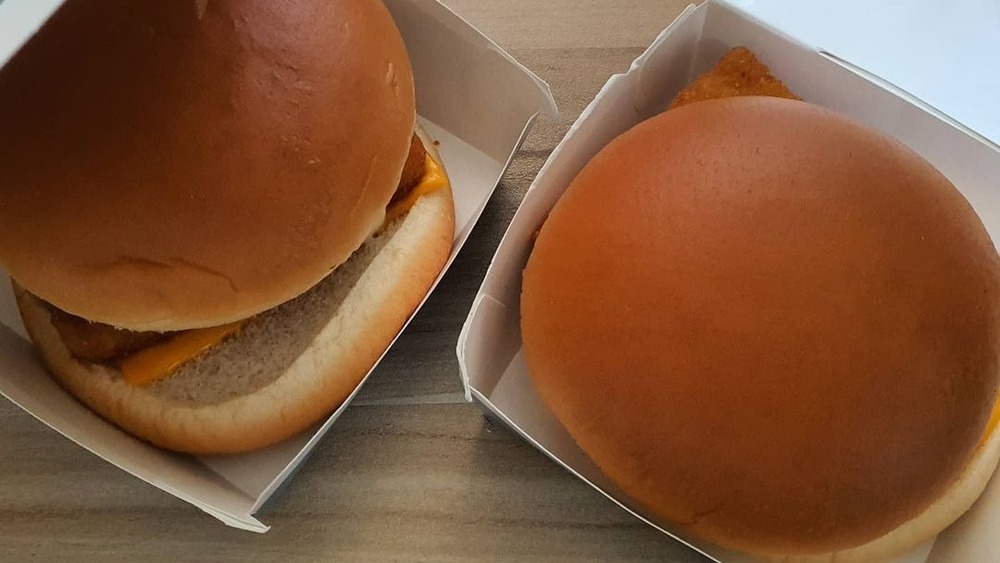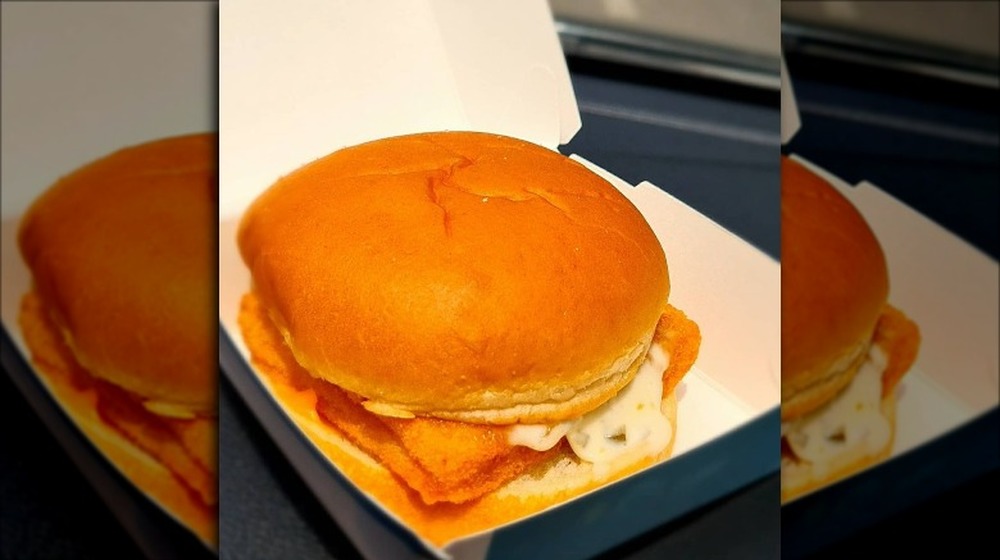This Is Why McDonald's Filet-O-Fish Is So Delicious
Love it or (love to) hate it, the McDonald's Filet-O-Fish is a fast-food classic. This sandwich has been around more years than the Big Mac, and is a staple on the McDonald's menu — so much so, Smithsonian Magazine reports, that McDonald's sells about 300 million Filet-O-Fish sandwiches per year, with about a fourth of those sandwiches sold during Lent (which makes sense given the sandwich's Catholic past). Clearly, it has history.
Becoming a part of McDonald's regular, nationwide menu in 1965, the Filet-O-Fish has inspired both love and a love-hate relationship for many fast-food diners. There's something to be said for the simple combination of a plain bun with a battered fish filet with a half a slice of American cheese and a slather of classic tartar sauce; it's a classic. On the other hand, many in the love-hate camp point out the sandwich is a bit sus. Is it really real fish? And why do they only give you half a slice of cheese? And why is the bun not toasted? We have questions.
As it turns out, there's a reason for everything, and it all adds up to what makes the McDonald's Filet-O-Fish so delicious.
McDonald's Filet-O-Fish patty is actually made out of real fish
Really! While you might automatically assume that McDonald's would cut corners and go with something fish-adjacent rather than real fish (like the meat-adjacent meat that customers have claimed for years exists in McDonald's hamburgers and chicken nuggets — even though this has been disproven), it's just not the case. Smithsonian Magazine reports that the Filet-O-Fish has contained real fish ever since it was first invented back in the '60s. The only real questionable aspect of the fish was whether or not it was sustainable, which is a valid question, considering that unsustainable fishing threatens the survival of many sea life populations (but more on that in a minute).
Wonder no more: the Filet-O-Fish patty is made from Alaskan Pollock (aka Walleye Pollock). According to Seafood Health Facts, a web project funded by the U.S. government, Alaskan Pollock is one of the most commonly consumed seafood species in the country, and all Alaskan Pollock is wild-caught in the ocean. In other words, there's no need to worry if your fish has been hanging around in a human-made pond for its entire life. Alaskan Pollock is known for its mild flavor, appealing texture, and versatility; it's suitable for use in fish sticks, fillets, and our beloved Filet-O-Fish.
McDonald's Filet-O-Fish is sustainably sourced
Yeah, yeah, the fish in McDonald's Filet-O-Fish is sustainably sourced. That's great for the environment and for the biodiversity of our oceans, of course, but how does that impact the taste? Can you really tell a difference in the fact that McDonald's sources its Alaskan Pollock sustainably versus some other way?
According to a variety of experts and those in the industry, yes, the way your fish is sourced does make a difference in the taste. Seafood brand TinCanFish notes that, often, unsustainable fish are grown on fish farms, fed poor diets, and exposed to less exercise and less extreme weather elements; the result is a fish with less fat and flavor. Sustainably sourced fish, on the other hand, that live in their natural habitat, enjoy a diverse diet and plenty of exercise, which leads to more flavor, more fat, and even more healthy attributes, like fatty acids and minerals.
By going with sustainably sourced, wild-caught Alaskan Pollock, McDonald's is choosing to take advantage of what Epicurous calls "one of the world's most abundant and sustainable seafood species... a fish that is so abundant and well managed that it will be available and thriving for generations to come." The result is a more flavorful fish fillet that's not only great-tasting, but also great for the planet and, on some level, good for your health, even if all the Filet-O-Fish's fattier components get in the way of its overall health ranking.
McDonald's does one very special thing to the Filet-O-Fish bun
If you think that the bun McDonald's uses for the Filet-O-Fish is better than the buns the restaurant uses for its other sandwiches, there's a good reason why: the chain steams the Filet-O-Fish bun — something it doesn't do for any other menu item. McDonald's burger buns are toasted instead. In the Filet-O-Fish's case, this makes for a fluffy, soft vehicle for the sandwich's other ingredients and a bun texture that matches nicely with the fried fish fillet and slathering of tartar sauce.
It's no surprise that this simple variation makes the Filet-O-Fish stand out among McDonald's other menu items. Steamed buns have been a defining factor for years for other fast-food chains, like White Castle, and many home cooks use the steaming method to plump up and add a little moisture to stale, store-bought buns. If you're not a fish fan, but are now a little intrigued as to just how good the Filet-O-Fish bun is, you can still try it without ordering the Filet-O-Fish. Just ask for the McDonald's employees to steam your burger bun when you place your order.
The half slice of cheese on McDonald's Filet-O-Fish is not a mistake
The first time you really looked at your McDonald's Filet-O-Fish rather than simply scarfing it down immediately, you may have noticed the half slice of cheese and thought, "Really? McDonald's is so cheap that they couldn't have even given me a whole slice of cheese?" But there's a reason for McDonald's only using a half a slice of American cheese on its Filet-O-Fish, and it goes beyond merely saving money. It's all about the flavor.
Addressing customer complaints over the half slices of cheese in a Journal Star article in 2010, a McDonald's spokesperson said, "It's always been that way... When you think of a cheeseburger, it's really cheesy. With the Filet, a half slice complements the taste, rather than overwhelming it." And when you think about it, the rationale makes sense. On a burger, the beef patty has enough flavor to compete head-to-head with a full slice (or multiple slices) of cheese; on the Filet-O-Fish, you're dealing with much more delicate flavors and textures, and throwing a lot of cheese on your mild fish and milder bun will detract from the overall experience.
In other words, rather than complain about the half slice of cheese, McDonald's recommends that you just sit back and enjoy the flavor.
The lack of lettuce on McDonald's Filet-O-Fish is a huge help
If you've ever had a McChicken or a Big Mac, you can likely attest to the fact that, most of the time, eating either results in watching lots of shredded lettuce fall from the sandwich onto the wrapper below you, onto your lap, or into your car. Shredded lettuce goes everywhere.
And when McDonald's formulated the Filet-O-Fish, it would've made sense for them to add shredded lettuce to that as well; after all, the mild iceberg lettuce flavor certainly wouldn't compete with those of the bun, cheese, sauce, and fish. Additionally, many fast-food fish sandwiches do indeed feature lettuce, including Arby's Reel Big Fillet fish sandwich, which prompted one LA Weekly reviewer to comment, "The hot iceberg lettuce is a bit of a bummer." On the flip side, the same reviewer praised McDonald's lack of lettuce, saying, "This sandwich seem[s] like the seafaring equivalent of the best drive-in steamed cheeseburger, with no pesky, flavorless hot lettuce to get in the way."
So, the lack of lettuce may not be entirely about flavor, but rather all about convenience. The Filet-O-Fish is a tasty treat you can eat on the go, without worrying about half your sandwich falling apart in the process.
There are real ingredients in the tartar sauce in McDonald's Filet-O-Fish sandwiches
Tartar sauce is pretty basic, but when it comes to McDonald's Filet-O-Fish, the tartar sauce used makes a big difference in the end result.
Easy enough to make at home, your basic tartar sauce includes usually mayo or aioli, some seasonings, and add-ins like capers, pickles, lemon, or dill, depending on where in the world you are. Related to Eastern European "tarator" sauce, which is often enjoyed with fried seafood, tartar sauce is not only eaten with your favorite fried fish sandwich, but also with beef tartare. McDonald's tartar sauce is made with soybean oil, pickle relish, eggs, water, onions, vinegar, sugar, spices, and a few thickeners and preservatives.
What makes the big difference for McDonald's tartar sauce? The chain's tartar sauce is actually made with real egg yolks and real herbs, like parsley (via LiveStrong), which gives it a fresher taste and a creamier texture. In fact, McDonald's tartar sauce was so popular at one point that, in 2017, the brand decided to bottle and sell its tartar sauce in select countries (like Canada) alongside bottled versions of its McChicken and Big Mac sauces.
Filet-O-Fish sandwich bread is extra fluffy thanks to one particular additive
Okay, so additives aren't always what you want in your food, but in many cases, additives are harmless when consumed in small, manageable amounts. To that end, there's one additive that you'll find in the McDonald's Filet-O-Fish bun that helps to give it that fluffy texture and delicious mouthfeel that so many Filet-O-Fish fans rave about. That additive is DATEM, as noted by LiveStrong, and it's essentially a dough conditioner or emulsifier. On a scientific level, DATEM helps strengthen bread dough so that it more reliably expands and puffs up during baking, which results in bigger, fluffier buns, and an overall finer crumb — and a better Filet-O-Fish for you.
Unfortunately, DATEM is a relatively controversial food additive, even though it's approved by the FDA; some consumers blame gluten intolerance-like symptoms on DATEM. For this reason, some brands have discontinued DATEM use in their products, including Whole Foods and Subway. However, for the time being, McDonald's is still finding it safe to use DATEM to make that Filet-O-Fish bread extra fluffy, extra steamy, and exactly what customers have loved for decades.
The size of McDonald's Filet-O-Fish is part of the deliciousness equation
When looking at what exactly makes a fast-food item just so scrumptious, you can't just zero in at the individual ingredients; things like size and serving style also influence your dining experience, and can make or break your initial impression of a menu item. To that end, for many Filet-O-Fish fans, the sandwich's size really helps make the sandwich what it is. Because the Filet-O-Fish is smaller than, say, a Big Mac or most of the other sandwiches on McDonald's menu, it's not so overwhelming — just like it's flavor. For those seeking something light, as well as easy on the stomach and the tastebuds, the Filet-O-Fish is the way to go.
On top of this, the smaller size of the Filet-O-Fish also results in a smaller price tag, which further adds to its appeal for many diners. As LA Weekly noted, "On special, these diminutive little sandwiches set you back about a buck and a half apiece. For that price, it's hard to imagine a convenience food that delivers more completely as a satisfying snack — except for nearly-worthless fruit."
McDonald's Filet-O-Fish is nothing special -- which is a good thing
Filet-O-Fish aficionados all point out one particular thing that sets the sandwich apart from its brethren: the Filet-O-Fish is not trying to be something that it isn't, and it's not claiming to be fancier than it is. It's simple, plain, and nothing special — and that works in its favor.
In an article proudly titled, "I quit all meats and fast food — except for the Filet-O-Fish," a writer from The Takeout noted that the Filet-O-Fish "takes four bland, largely unappealing components, and fuses them together, elevating it into something you're not proud of loving, but is inexplicably addictive." A similar LA Weekly article expresses much the same sentiment: "the Filet-O-Fish hasn't forgotten what it most essentially is... It's not trying to make you think that eating a fried fish sandwich in your car is the same thing as eating a fried fish sandwich in a restaurant."
The Filet-O-Fish is honest and open about what it is: a steamed bun, battered and fried Alaskan Pollock, tartar sauce, and pasteurized processed American cheese. No more, no less.
McDonald's Filet-O-Fish sandwich has a mild seafood flavor
There's a reason most kids like fish sticks, but not sushi: the types of fish used for fish sticks and McDonald's Filet-O-Fish, like Alaskan Pollock, are generally very, very mild; That makes them appeal to those who can't really stand the stronger tastes of traditional, fresher, or more pungent seafood. As The Takeout explained, "the Filet-O-Fish is the gateway drug that turns people on to the wider world of seafood. Which is ironic, because delicious as it may be, there's almost no fish-based meal that tastes less like fish."
Alaskan Pollock in general is known for being mostly inoffensive to those who find seafood, well, gross. Global Seafoods North America even calls Alaskan Pollock one of "the best fish for someone who doesn't like fish," and recommends it as a starter fish for those who want to add more seafood to their diets, but who don't care for the taste.
McDonald's Filet-O-Fish boasts a mixture of textures
Another thing that McDonald's really has working in its favor when it comes to the Filet-O-Fish? Textures. Unlike a Big Mac, which is pretty much soft on soft on soft, the Filet-O-Fish mixes a few key textures together to create one enjoyable experience. You have the soft, fluffy, steamed bun; the crispy and flaky fish patty; the slick and partially-melted processed cheese; and the dollop of thick and creamy tartar sauce. Yum.
Don't think that texture is that big of a deal when it comes to creating an amazing food experience? That everything comes down to flavor alone? Think again. Food texture expert and author Ole G. Mouritsen noted on The Splendid Table that, in blind tests of pureed foods, study participants can usually only identify foods about a third of the time by taste alone; without texture, taste becomes a bit meaningless.
So, even if you find the individual ingredients that make a Filet-O-Fish unappealing, once you add all four together, you could find that the overarching texture and mouthfeel makes for a completely different experience than, say, just eating an Alaskan Pollock patty plain.
McDonald's Filet-O-Fish isn't very healthy -- and that's just the way it should be
Fish? Normally considered healthy. Smaller portion sizes? Also usually considered healthy. Fewer calories? Pretty much a clear indicator that something is healthy. So, if one were examining the McDonald's menu, one would assume that the Filet-O-Fish is one of the healthiest menu items, right? It's smaller than most of McDonald's other menu items, has only 390 calories, and features fish.
However, when you break down how much total food you're getting in a Filet-O-Fish and compare it to the amount of calories in the sandwich, it turns out that the Filet-O-Fish isn't the healthiest McDonald's menu item at all. Per ounce, a Filet-O-Fish is 78 calories (via CNBC). Meanwhile, a Double Quarter Pounder with Cheese is only 75.5 calories per ounce. Additionally, the Filet-O-Fish can account for nearly 20 percent of your daily recommended saturated fat intake, nearly 25 percent of your overall total daily fat intake, as well as 25 percent of your daily recommended sodium intake.
So is the Filet-O-Fish healthy? No, not really. But it's good, and that's partially thanks to the fact that it's not as healthy as you think it is. All that fat appeals to your senses and just makes the Filet-O-Fish that much tastier.
